After a walk in NYC’s underbelly down Hell’s Kitchen’s 8th Avenue, a trip down Brooklyn’s 8th Avenue in Park Slope shapes up to be rather a change of pace. As you can tell by the unleaved trees this trip actually preceded my Manhattan 8th Avenue foray [Porn Under a Bad Sign]
Though it seems the last vestiges of Manhattan’s old Deuce are doomed to disappear after being swept out by a development binge on Manhattan’s West Side, the century-old delights here have Landmarks Preservation Commission protection and are likely to stay where they are. Let’s take a look at just a few…
Eighth Avenue runs between Park Slope (Flatbush Avenue) and Bay Ridge (7th Avenue and 73rd Street) but actually exists in three sections: one between Flatbush Avenue and 18th Street; an intrerruption for the Prospect Expressway; a short 1-block stretch from 19th to 20th Street; an interruption for Green-Wood Cemetery; and another run in Sunset Park and Bay Ridge beginning at 39th Street. In effect it is divided into Park Slope and Sunset Park sections and each are completely disparate.
I began at the Prospect Expressway. Here is an unusual pedestrian crossing surrounded by fencing designed to keep local miscreants from throwing objects onto traffic below. (The more forgiving side of me merely says it’s there to provide better protection for pedestrians).
RIGHT: attached buildings and corner deli at Windsor Place. When built these were modest dwellings designed for working people but as real estate has appreciated and modern building styles have deteriorated these houses have taken on the patina of desirability as the decades have passed.
Baptized by Fire
The 14th Regiment Armory at 8th Avenue between 14th and 15th streets was designed by William Mundell and built between 1891 and 1895. The U.S. Army’s 14th Regiment was organized in the 1840s and was known as the Red Legged Devils, since their dress uniforms were based on the flamboyant Zouave style favored by the French at the time, featuring bright blue jackets and red pants.
The “Red Legged Devils” were the only regiment to fight in all three days of the Battle of Gettysburg. They have been honored by having three monuments erected at National Battlefield Park in Gettysburg, Pennsylvania.
The lavish interior features a spacious entrance hall, which is dominated by a handsome double staircase with fluted Corinthian columns, a large and elaborate stained-glass window attributed top Louis Comfort Tiffany [moved in 1995 to the Staten Island Armory] turned balusters and paneled newel posts surmounted by bronze torcheres. massive chestnut trophy cases line the hallways.
On the second story, the most impressive space is the officers’ room, with features chestnut paneled walls, a coiffered ceiling adorned with elaborate pressed metal and supported by fluted Corinthian columns and a marble fireplace with a massive, carved chestnut overmantel. Nancy L. Todd, New York’s Historic Armories
A look at the 15th Street side.
…The 14th Regiment became the only Brooklyn National Guard organization to serve a full three-year term of enlistment in the Civil War. The state refused to call them out, but at length the order came directly from President Lincoln for the regiment to proceed to Washington. On that memorable afternoon of May 18, 1861, the regiment moved out of Fort Greene PRK AT lieutenant Colonel Edward B. Fowler?s command. (Colonel Wood then being at the capital) and proceeded down Myrtle Avenue to Fulton Ferry to the strains of “The Girl I Left Behind Me,” For many years thereafter, on May 18th, the Civil War veterans tendered an annual “Campfire” dinner to the officers active regiment. The last surviving Civil War veteran was Corporal Frederick N. Saunders of Company B. He died on October 31, 1939, at the age of 96. He is buried at Pinelawn National Cemetery.
….When the regiment reassembled at Arlington, word was received from Albany that the State authorities had changed the number of the regiment. Henceforth, the message stated, it would be known as the 84th New York Volunteers. Immediately there was a storm of protest from officers and men alike. An appeal was made to the federal government. Happily, General McDowell was soon thereafter able to say “You were mustered by my into the service of the United States as part of the Militia of the State of New York known as the Fourteenth; you have been baptized by fire under that number as such you shall be recognized by the United States Government and by no other number.” The regiment was also known as the “14th Brooklyn” or sometimes the “Brooklyn Chasseurs.” The 14th Brooklyn Society
A small plaque to the right of the front door marks what is purportedly a small stone removed from the battlefield at Gettysburg, Pennsylvania. The stone was donated by 14th Regiment veterans and reads: “All of which I saw, part of which I was.”
The WWI statue was sculpted in 1923 by Anton Scaaf.
The Taft, near the Armory, was likely built when you know who was President. RIGHT: turreted building at 12th Street and 8th Avenue.
On 8th Avenue it’s one winner after another, as we’ll see. PS 107, the John W. Kimball School, was completed in Romanesque Revival style in 1894 by J.M. Naughton between 13th and 14th Streets.
Above, corner 11th Street; right, corner 8th and 8th; bottom, north side, 8th Street
Something just occurred to me: I never tire of visiting Park Slope because of the architecture and the sense that the builders, long ago, between 1880 and 1910, were attempting to build something that would be looked on with awe and admiration for as long as the buildings stood.
What if they weren’t? What if they were building according to a template or some kind of current design specs? Just like the developers infesting Queens and other boroughs do now?
In other words, what if I’m wrong and all the so-called bad housing I complain about now will later be invested with a sheen of nostalgia and respectability that future residents…the ones in 2070 or 2080…will look back on them with a nostalgic gloss and complain about the bad stuff they’re seeing when that day comes?
Did people in the 1880s-1910s complain about these buildings? After all, if you’re not crazy about the syle, or the design, the rote repetition you see on some of these blocks…the very quality I find attractive about them…is echoed in the cookie cutter identikit buildings you see now, only with less care, less detail, less attention to aesthetics.
St. Saviour’s R.C. Church and school, 8th Avenue and 6th Street. The parish dates to 1905. There are scores of churches in the USA and Europe named St. Saviour’s — including a threatened 1847 Renwick in Maspeth — but what is the derivation for this name? Was there a saint named Saviour, or is this a reference to Jesus Christ? If so, why “saint”?
ForgottenFan Dr. Mitchell Balish: In response to your query about the identity of St. Saviour, I have an answer. (And I’m not even Catholic!) You have to bear in mind that “Saint” is not a title, like “Doctor,” but rather just an adjective in French meaning “holy.” Just as “St. Peter” means “holy Peter,” “St. Saviour” means “holy savior.” Consider the Spanish version of this that we see out west in cities named “Santa Cruz” (“holy cross”) and Santa Fe (“holy faith”). So in fact, it is indeed a reference to Jesus.
New York Methodist Hospital’s main campus, 506 6th Street, takes up the entire block between 6th and 7th Streets and 7th and 8th Avenues. In this picture the older and newer wings of the hospital can be discerned.
8th Avenue temporarily gains a wider sidewalk between 6th and 5th Streets.
As we approach the northern end of 8th Avenue, the architecture gets even more detailed and involving. My guidebooks are silent on these buildings on 8th Avenue and 4th Street (top right, 4th itself) but many of the buildings in the area look like these. Apartment buildings seem to dominate 8th Avenue, while two-family buildings and even some brownstone mansions hold sway on the side streets.
Two streets in Park Slope are named for assassinated Presidents: Linclon and Garfield Places. (A bust of John F. Kennedy is being renovated and will be returning to Grand Army Plaza.)
At the corner of Garfield is one of upper 8th’s most distinctive buildings and one of Brooklyn’s great domes, the Temple Beth Elohim. Like many of its surrounding buildings it dates to a few years either side of 1900 — with this one being designed by Eisendrath and Horowitz and completed in 1910.
The diagonal orientation to the street
is not only a splendid urbanistic gesture but also signalizes that the building is pentagonal in plan, symbolizing the Pentateuch. There is nothing better than when urbanism and symbolism are so seamlessly mated. Francis Morrone, An Architectural Guidebook to Brooklyn
Montgomery
In a neighborhood of showpiece buildings the two blocks most-remarked upon and cited by architecture writers and critics are Carroll Street and Montgomery Place between 8th Avenue and Prospect Park. If you only have a short time to kill in Park Slope, Montgomery Place is the block you should visit, especially in fall, winter or early spring when the leaves are down and the architecture is in full view. Most of the buildings were developed for realtor Harvey Murdock between 1888 and 1892 and designed by the same architect, C.P.H. Gilbert, in the Romanesque Revival style. Gilbert also designed several mansions along Fifth Avenue’s “Millionaire’s Row” along Central Park.
Of special note are Murdock’s own house in rustic style, No. 11, No. 19 with its semicircular arches, and No. 47, built from red sandstone by R.L. Daus, one of a handful not done by Gilbert.
19 Montgomery Place; right, 25 Montgomery Place
14 Montgomery Place (right)
47 Montgomery Place
78 8th Avenue at Union Street. Your webmaster enjoyed the 15 over 15 windows and the two conquistadors in the front.
Author Ian Frazer has not one but two essays on plastic bags in trees in Gone to New York: Adventures in the City (Picador, 2006)
8th Avenue and Union Street. Architects of the Victorian era had a way of designing buildings with wildly diverging shapes and angles, and somehow making it all work as a cohesive unit. Today, designs like this would be thought of as indulgent and wasteful by many, unfortunately. Feast the peepers on all the chimneys, towers and gables, including the “thimble” that holds down the corner and draws in the eye, in this Queen Anne style building built in 1887 by Lansing Holden for a Mrs. Phillips. Wouldn’t you like a room in the corner tower to watch Brooklyn pass by? An added fillip is the flowering tree in the front yard investing the splendor with spring color.
Beautiful and (Brown)stoned
Here’s the coup de grace, or as they say it in Brooklyn: coop dee grayse.
As it says in the ForgottenBook: The Montauk Club is a slice of Victoriana that would be pretentious if it weren’t so enjoyable and fun to view when walking past. The club itself was established in 1889 as a “gentleman’s social club”; a plaque at the front entrance describes its (completed in) 891 building at 8th Avenue and Lincoln Place as modeled by architect Francis Kimball after the Ca’ d’Oro in Venice. There is a lengthy frieze above the third floor depicting the “exploits of the Montauk Indians”, as the plaque puts it, in terra cotta. On the second floor arch, you’ll find another frieze showing the club’s founders laying the cornerstone. Stained-glass windows punctuate the three-sided exterior, and arches with quatrefoil, or 4-leaf clover-shaped, spaces. Yet another frieze above the second story depicts a Montauk sachem, Wyandance (who also gave his name to a small town in Suffolk County) deeding property to a Lion Gardner of Easthampton, Long Island, in 1659. The club occupies only the lower two floors, while co-op apartments occupy the others.
Four presidents have visited the Montauk: Cleveland, Hoover, Eisenhower and Kennedy, and Mark Twain gave a short talk at the Montauk on April 27, 1901. The Montauk Club has an open house the first Friday of each month: call (718) 638-0800 or visit www.montaukclub.com for details.
You know what, I’m going to run up my webhost bill this month for this, but I’m going to show some of the friezes surrounding the building full size so you can see them better…because you have to see them…
The cornerstone is laid in 1889 (yes, December 14, 1889; why the frieze says 1890 is unknown)
The Montauk Indians
Missionaries arrive in the New World
The American Revolution
Manifest destiny
Charles T. Willis, regarded as the finest stonemason in NYC at the time, was in charge of construction. Probably Willis’ other best-known building is the Pierpont Morgan Library, recently (2007) reopened after extensive renovation, on Madison Avenue and East 36th Street. Here is a closer look at the Lincoln Place side’s terrace and quatrefoils (4-lobed openings; when they have 3 lobes, they’re called trefoils; with 5 lobes, they’re called cinquefoils) between the arches.
The 1st, 2nd and 3rd floors were used for dining and entertaining with the top two floors featuring accommodations for guests. There was a bowling alley in the basement. Innovatively, for its day, members’ wives were also allowed full access–though women needed to use a separate entrance.
Lions’ head brackets support the terrace. The 1st-floor windows feature stained glass and are screened by trefoils. each floor of the Montauk, which has three exposures, boasts a completely different architectural treatment.
The heavy iron fence on the Lincoln Place side features depictions of fierce Montauk warriors on the posts.
The doorways and even knockers depict the Mohawk. These renderings may be considered clichéd or perhaps offensive if attempted today. But would this sort of woodwork, carving, design, even be proposed in 2007, when glass fronted buildings are the new brownstones?
ForgottenFan Steve Garza visited the Montauk Club in 2006
8th Avenue ends at Flatbush Avenue. The avenue’s diagonal orientation creates several triangle parks; in this one we find a faux gaslight and several ubiquitous newspaper boxes.

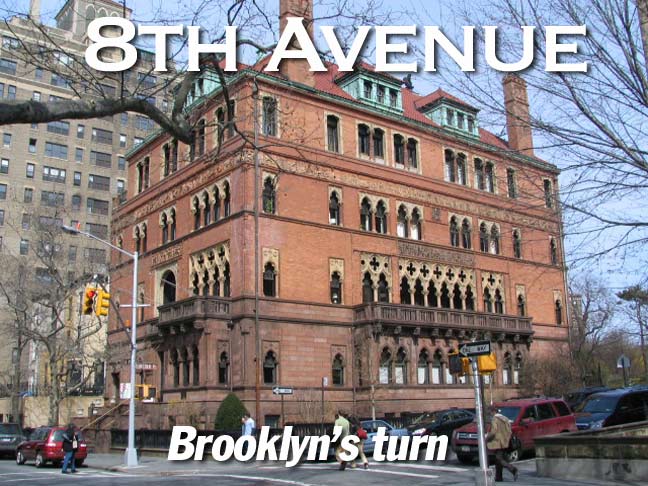
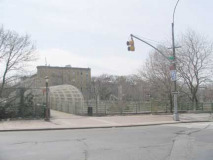
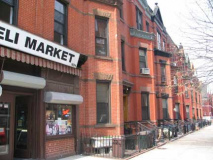
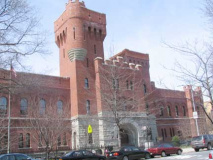
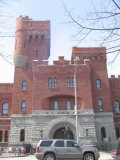
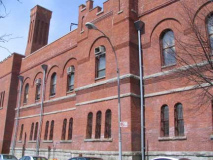
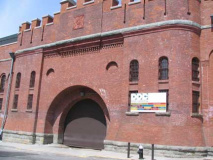
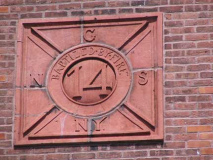
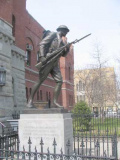
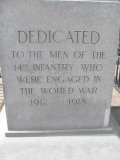
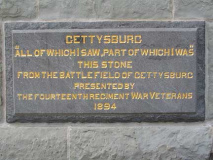

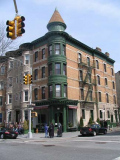
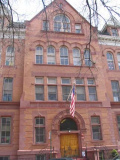
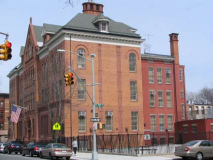


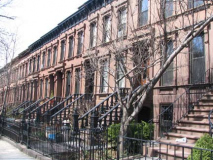
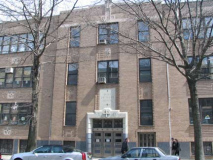
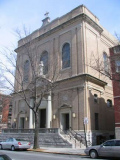
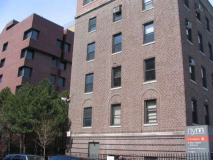
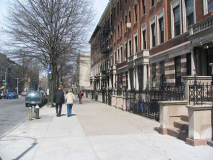
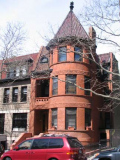
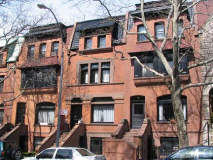
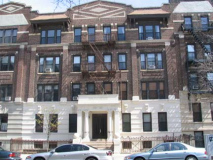
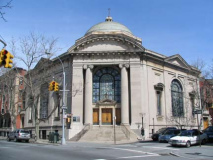

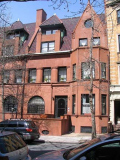
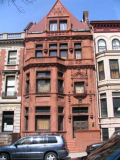
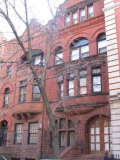
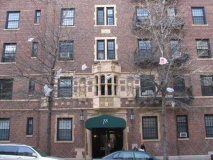

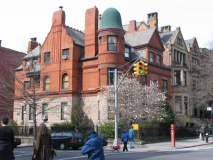
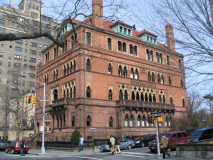
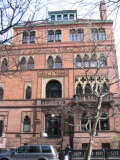
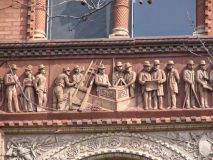
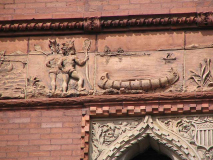
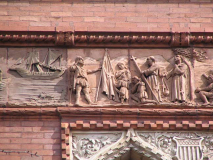

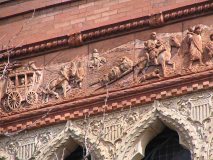
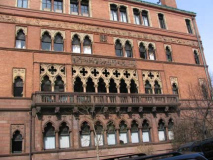


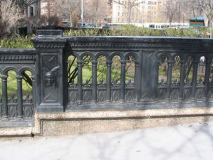

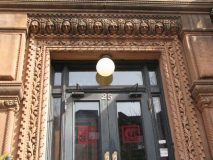
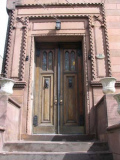
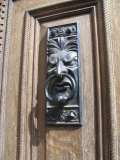
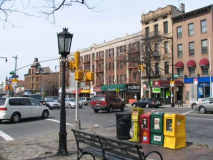
1 comment
[…] be most appreciative. Maybe you can learn to play chess or use this interesting story about the building’s history to entertain the residents. And who knows, maybe you’ll have a love connection with Nurse […]
Comments are closed.